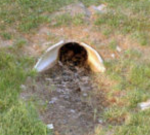So I'm trying to figure out the approach to fixing a problem with my road eroding.
I live about a mile off the pavement, with a dirt/gravel road that I maintain as the only access to my property. Last year, I had drainage put it that has helped prevent the big problems it used to have, with thick mud and massive ruts, but there is another problem that's been creeping up for a few years, and it's time to address it.
Part way down, there is a creek that passes under the road. It has a culvert that's been there for years, possibly decades - no idea how long. Most of the time, this is fine, but in heavy rain the road runoff cuts it a bit, and if it gets bad enough, we end up with the creek flowing (rather quickly) OVER the road, which I think is a big contributor to the problem.
So I'm looking for ideas on how to fix this before I don't have a road anymore!
Some pics of the problem - flow is right to left in all pics:

Where it goes under. You can see the erosion at the top where it's starting to cut into the top of the road.

Another view of that spot. The inner part of that crescent is probably a good 3-4 inches more worn that it was when we moved in (6 years ago) and it seems it's been getting faster. During heavy rain, the water runs down over this spot, and when it floods this is the spot that gets hit by the full rush.

Better view underneath where the water enters. I'm pretty sure the primary path is the one on the right, not sure where the one on the left leads, but I'm guessing they probably both go to the pipe, but that something ended up splitting the inflow.

Here's the outflow side. You can see the pipe where it discharges. The USUAL drop is about 2-3 feet when it's at the usual level. You can see at the right side of the pic the corresponding drop where the water crosses when flooded.
I have a couple thoughts on what to do with this but would like input from people who know more about it than I do before settling on an approach.
I live about a mile off the pavement, with a dirt/gravel road that I maintain as the only access to my property. Last year, I had drainage put it that has helped prevent the big problems it used to have, with thick mud and massive ruts, but there is another problem that's been creeping up for a few years, and it's time to address it.
Part way down, there is a creek that passes under the road. It has a culvert that's been there for years, possibly decades - no idea how long. Most of the time, this is fine, but in heavy rain the road runoff cuts it a bit, and if it gets bad enough, we end up with the creek flowing (rather quickly) OVER the road, which I think is a big contributor to the problem.
So I'm looking for ideas on how to fix this before I don't have a road anymore!
Some pics of the problem - flow is right to left in all pics:
Where it goes under. You can see the erosion at the top where it's starting to cut into the top of the road.
Another view of that spot. The inner part of that crescent is probably a good 3-4 inches more worn that it was when we moved in (6 years ago) and it seems it's been getting faster. During heavy rain, the water runs down over this spot, and when it floods this is the spot that gets hit by the full rush.
Better view underneath where the water enters. I'm pretty sure the primary path is the one on the right, not sure where the one on the left leads, but I'm guessing they probably both go to the pipe, but that something ended up splitting the inflow.
Here's the outflow side. You can see the pipe where it discharges. The USUAL drop is about 2-3 feet when it's at the usual level. You can see at the right side of the pic the corresponding drop where the water crosses when flooded.
I have a couple thoughts on what to do with this but would like input from people who know more about it than I do before settling on an approach.


